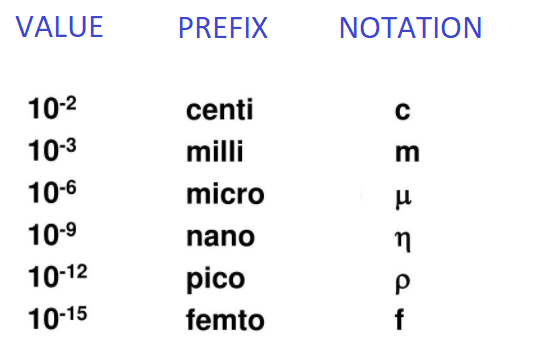
$ 1\mu $ is
(A) $ {10^{ - 6}}m $
(B) $ {10^{ - 9}}m $
(C) $ {10^{ - 10}}m $
(D) $ {10^{ - 3}}m $
Answer
474.9k+ views
Hint: To measure the quantities we define a unit for them. Meter is a unit of length. We use scientific notations to write very small or very large numbers. Scientific notation is used when a number between $ 1 $ to $ 10 $ is multiplied by a power of $ 10 $ . Here, we will discuss these scientific notations, particularly, metric prefixes. They make calculations easy and error-free.
Complete answer:
We have a whole table of standard notations shown below in the picture.

A metric prefix is a unit that precedes a basic unit of measurement to indicate a multiple of the unit. All the metric prefixes used are decadic and each prefix has a unique symbol. They are very helpful, to write very large and very small measurements.
From the table, we can see that $ 1\mu $ is a metric prefix $ {10^{ - 6}} $ .
Hence, the correct option is (A) $ {10^{ - 6}}m $ .
Note:
Very common metric prefixes are centi $ \left( c \right) $ , milli $ \left( m \right) $ , micro $ \left( \mu \right) $ , nano $ \left( n \right) $ , pico $ \left( p \right) $ , Giga $ \left( G \right) $ , mega $ \left( M \right) $ , kilo $ \left( k \right) $ , hecto $ \left( h \right) $ .
A metric prefix is always followed by a SI unit.
To write the numbers in scientific notation, there are some rules.
-It is always written in base $ 10 $ and the power of $ 10 $ carries either positive or negative signs.
-The value of the coefficient is (either positive or negative) of $ 10 $ is less than $ 10 $ and equal to or greater than $ 1 $ .
-When we move the decimal to the left the power of $ 10 $ increases. Similarly, when we move the decimal to the right, the power of $ 10 $ decreases.
Complete answer:
We have a whole table of standard notations shown below in the picture.

A metric prefix is a unit that precedes a basic unit of measurement to indicate a multiple of the unit. All the metric prefixes used are decadic and each prefix has a unique symbol. They are very helpful, to write very large and very small measurements.
From the table, we can see that $ 1\mu $ is a metric prefix $ {10^{ - 6}} $ .
Hence, the correct option is (A) $ {10^{ - 6}}m $ .
Note:
Very common metric prefixes are centi $ \left( c \right) $ , milli $ \left( m \right) $ , micro $ \left( \mu \right) $ , nano $ \left( n \right) $ , pico $ \left( p \right) $ , Giga $ \left( G \right) $ , mega $ \left( M \right) $ , kilo $ \left( k \right) $ , hecto $ \left( h \right) $ .
A metric prefix is always followed by a SI unit.
To write the numbers in scientific notation, there are some rules.
-It is always written in base $ 10 $ and the power of $ 10 $ carries either positive or negative signs.
-The value of the coefficient is (either positive or negative) of $ 10 $ is less than $ 10 $ and equal to or greater than $ 1 $ .
-When we move the decimal to the left the power of $ 10 $ increases. Similarly, when we move the decimal to the right, the power of $ 10 $ decreases.
Recently Updated Pages
Why are manures considered better than fertilizers class 11 biology CBSE

Find the coordinates of the midpoint of the line segment class 11 maths CBSE

Distinguish between static friction limiting friction class 11 physics CBSE

The Chairman of the constituent Assembly was A Jawaharlal class 11 social science CBSE

The first National Commission on Labour NCL submitted class 11 social science CBSE

Number of all subshell of n + l 7 is A 4 B 5 C 6 D class 11 chemistry CBSE

Trending doubts
1 Quintal is equal to a 110 kg b 10 kg c 100kg d 1000 class 11 physics CBSE

Why is steel more elastic than rubber class 11 physics CBSE

What is boron A Nonmetal B Metal C Metalloid D All class 11 chemistry CBSE

What is Environment class 11 chemistry CBSE

Bond order ofO2 O2+ O2 and O22 is in order A O2 langle class 11 chemistry CBSE

How many squares are there in a chess board A 1296 class 11 maths CBSE




